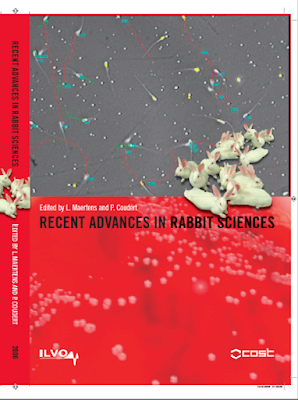I just wanted at share some interesting tidbits gathered from rabbit research around the world, resulting in a journal called "Recent Advancements in Rabbit Sciences" Edited by L. Maertens and P. Coudert. This book was a joint effort of COST (European Cooperation in the field of Scientific and Technical Research) to consolidate fragmented, short term and discontinuous rabbit research into one area. Fourteen countries participated. The journal is in pdf format and available to download so you can read all 309 pages at your leisure haha. NOTE: The page number where I found the information is in parenthesis.
- Artificual insemination (AI) is widely used on European rabbit farms. This required the use of hormones to keep all does on the same breeding cycle. Recent regulations have forced European rabbit farms to look at nonhormonal methods to improve reproductive performance. Here is what researchers have found:
- Scientists have discovered that cage changing, or doe gathering, before insemination has not clearly been shown to increase doe receptivity. Some studies said YES, some studies said NO. Scientists must be able to reproduce results before they can say it works (31).
- If you are breeding a doe with a litter, controlled nursing applied 2 or 3 days before mating (by closing access or removing nestbox) is effective. Receptivity is best when mating occurs right after the doe nurses her kits. Controlled nursing works best for mating receptivity if kits are completely removed from doe's area...no smell, no sight, no hear (34).
- The "buck effect"...placing a doe in the cage next to a buck, was not shown to increase receptivity as it does in other animals. What?! This made such sense to me so I was surprised it could not be easily proven. The "buck effect" works with other animals...with rabbits, not so much. However, bucks in the cage next to a young doe can induce sexual maturity and receptivity in those young does...not in older does, though (41-42)...so all is not lost.
- Investigations show that does prefer to jump on an elevated seat if possible. A second floor is used by does as a withdrawal area from pesky kits. The floor material of second floor is important to consider because solid surfaces (such as wood) can carry risk of endoparasite infection (81) and slots can get manure and urine on kits below.
- In the last few days before kits are born, their nostrils open up and they can smell the food that has passed through the placenta from the mother's diet . If a kit is born to a doe fed parsley during gestation, they will be naturally drawn to parsley odors after birth. This preference continues through weaning, with kits displaying a preference towards the foods the doe has eaten(88-89). How cool.
- Controlled nursing (removing nestbox from mother's cage and replacing on a time schedule) kits remained in the fear freeze stance for less time than free-nursed kits in experiments. These kits also had a higher growth rate and a higher degree of relaxation. I am jealous of these kits and their higher degree of relaxation.
- Kits are highly senstive to people handling them in the first period of life so it is important to handle them. This lowers their stress reaction due to the 'fear' of humans after weaning (93). A higher tolerance to stress means stronger immune systems. It's a win-win.
- These handled kit's reduced fear is long lasting and specific to the handler species. If you want your kits to be people friendly, handle them when you take them over to mama for nursing. These handled kits later showed higher conception rates when mature than non handled ones, too. The optimal window for handling kits for reduced fearfulness is 15 minutes before and 30 minutes after nursing during the first week of life(103-104). These little guys connect us to happy, feel good nursing activities. Kits handled like this are said to be 70% more bold, making better people rabbits...if you raise fancy breeds.
- During a group housing experiment, it was found that solid floors are not recommended due to urine and dropping contamination, causing disease. Floors should be perforated. Alternative floors such as plastic slats (baby pig slats/MIK flooring) experienced more sore foot lesions(113). The use of footrests on wire netting floors is recommended to provide a comfortable resting area and void footpad injuries(116, 119). Wire netting walls are also recommended to allow individually housed rabbit does to have social (visual) contact with their neighbors(117, 119).
- Research has found that a combined method of controlled and free nursing is best when raising kits. Free nursing during the first week of life and controlled method afterwards. Milk production of does was not affected by the nursing method. There were differences though, if mom was a first timer. First time mothers and litters benefited from controlled nursing with lower mortality rates. However, experienced mothers did better with free nursing (119). The combined method is a good compromise.
- Cages (size, equipment, etc.) used in rabbitries are suitable for production and also that they have no harmful effects on welfare (119). There it is...in writing...in a scientific journal.
- HOWEVER, The addition of a wooden stick, or other environmental enrichment, in rabbit cages had a positive effect on rabbit productive traits, behavior, carcass and meat characteristics. AND such enrichment is a good way to improve public image of intensive breeding programs (125).

Wow! Excellent post, very interesting to read about this. Thanks for sharing.
ReplyDeleteSo glad you liked it :) I definitely learned a few new words.
ReplyDeleteFascinating research! - esp. the importance of handling kits early to reduce fear of humans later and the benefits of controlled nursing for first time mothers. Thanks for giving us the Cliff Notes version of it=)
ReplyDeleteLOL! I hadn't thought about Cliff Notes since Shakespeare...I have to admit that I enjoyed this a lot more than good ole' William S. (Forgive me, Mother) ;)
ReplyDelete